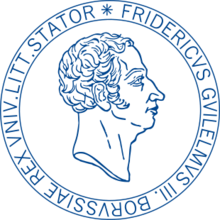 68
68 


With almost 200 years of history, about 36,000 students and an outstanding reputation at home and abroad, the University of Bonn is one of Germany’s leading universities. A total of about 500 professors are employed in teaching and research. In addition there are several thousand academic and non-academic staff in the academic, technical and administrative fields, making the University one of the region’s largest employers. Seven faculties form the University’s academic core. They have developed gradually as products of the University’s history, with some of them tracing their roots back to the foundation of the University in 1818: Faculty of Catholic Theology Faculty of Protestant Theology Faculty of Law and Economics Faculty of Medicine Faculty of Arts and Humanities Faculty of Mathematics and Science Faculty of Agriculture Research Profile The reputation of the University of Bonn for excellence in research is rooted in a long tradition. The University was founded in 1818 by Friedrich-Wilhelm III, the Prussian king whose name it bears. Imbued with the spirit of Wilhelm von Humboldt, the University quickly joined the circle of Germany’s most distinguished universities and became a major pole of attraction for leading scholars. The list of famous professors ranges from the astronomer Friedrich Wilhelm Argelander (1799-1875), through the chemist August Kekulé von Stradonitz (1829–1896) and political economist Josef Schumpeter (1883–1950) to the philologist Ernst Robert Curtius (1886–1956) and the theologists Karl Barth (1886–1968) and Joseph Ratzinger (born 1927), later to become Pope Benedict XVI. Today, the University of Bonn is a modern research university with a strong international orientation and a clear research profile. The University has developed internationally renowned areas of excellence in the fields of mathematics, economics, physics/astronomy, chemistry, biosciences, pharmacology, genetic medicine, immunology, neurosciences and ethics. Other disciplines, such as geosciences and law, are of outstanding importance within the German research scene. In recent years, the University of Bonn has proven its research potential and its commitment to academic excellence in numerous ways. The University can boast of a long list of award-winning scientists and scholars, e.g., with more than a dozen Leibniz Prize winners. Indeed, in the last 25 years two professors have received the Nobel Prize: Wolfgang Paul (for Physics, 1989) and Reinhard Selten (for Economics, 1994). Employing a range of funding instruments, the University makes every effort to further sharpen its profile and to offer its top-level researchers the best possible conditions in which to work. High-achieving research fields are granted special allocations for staffing, facilities and materials. The University rewards successful bids for third-party funding with its own allocations under a bonus system and supports the best initiatives for new collaborative projects with seed money awarded through an internal competition. In this way, successful researchers receive recognition and reinforcement for their efforts. National and International Research Cooperation As a research university, the University of Bonn builds alliances with strong partners at all levels. It has developed close relations with the major research institutions in the region such as the Forschungszentrum Jülich, the Deutsche Zentrum für Luft und Raumfahrt (DLR), the Center for Advanced Studies and Research (caesar), the newly founded German Center for Neurodegenerative Diseases (DZNE) and the local institutes of the Fraunhofer Society and Max Planck Society. Internationally, the University of Bonn has established a wide-ranging network of partners both at the institutional and interpersonal level: Active cooperation and exchange agreements with more than 300 institutions around the globe form a sound basis for the university’s international reputation. Academics from Bonn are working in more than 1,500 international research groups or projects with colleagues from around the globe. The University strongly supports further initiatives for collaboration with other universities and research institutions. Similarly, the University hosts a constantly growing number of international researchers – a trend confirmed by Bonn’s leading position in the statistics on grants and fellowships awarded by organizations like the prestigious Alexander von Humboldt-Foundation. Research-oriented teaching With about 36,000 students Bonn ranks among the big German universities. Each year more than 3,000 students graduate from Bonn; and in addition around 700 doctorates are awarded. Bonn is a classic university with a full range of courses. It offers about 90 undergraduate programs ranging from A for Asian Studies to Z for Zoology, with many interdisciplinary and international course models. In order to recruit excellent international PhD students for the University’s key research areas, the University of Bonn has established the Bonn International Graduate School (BIGS) system. These purely English-taught PhD-programs in fields such as mathematics, economics, physics/astronomy, pharmaceutical science and chemical biology have strongly contributed to Bonn’s character as a truly international research university. Infrastructure The University of Bonn and the City of Bonn are closely intertwined. The University owns or uses more than 350 buildings throughout the Bonn area. The most impressive building, located in the heart of the City, is undoubtedly the historic Main Building, which was originally the palatial residence of the prince elector and is now home to the Faculties of Philosophy and Theology as well as the University Administration. Together with the adjacent Hofgarten park, this architectural landmark is an important ingredient of the University’s unmistakable charm. Other important university sites include the nearby Juridicum (Faculty of Law and Economics) and the grand buildings in the Poppelsdorf district, housing Pre-clinical Medicine, Agriculture and Natural Sciences. The research institutes and teaching hospitals of the Medical School are located above the City in Bonn’s Venusberg district. Newly constructed or acquired buildings, such as the state-of-the-art Life and Medical Sciences (LIMES) building or the Hausdorff Centre for Mathematics, which is housed in a distinctive palace-like building from the early 20th century, reflect the University’s successful effort to develop an infrastructure corresponding to its research profile.
 68
68 
| Subject | Rank |
|---|---|
Agricultural Sciences | 34 |
Mathematics | 38 |
Economics | 41 |
Remote Sensing | 51-75 |
Human Biological Sciences | 51-75 |
Atmospheric Science | 76-100 |
Biological Sciences | 76-100 |
Dentistry & Oral Sciences | 76-100 |